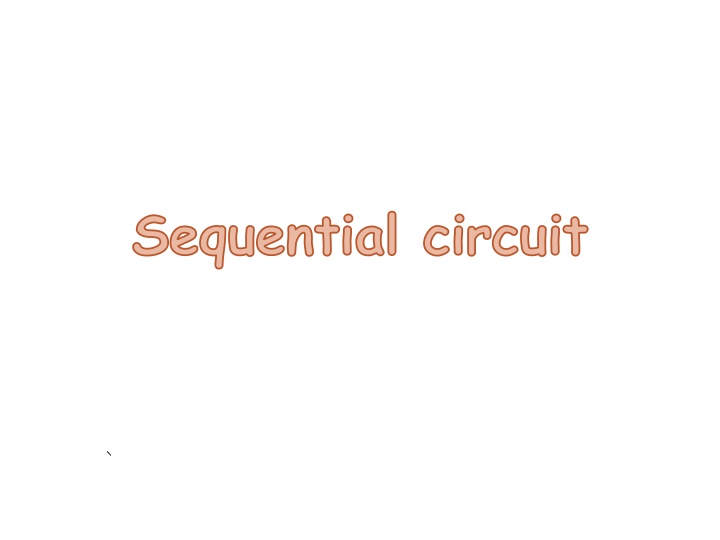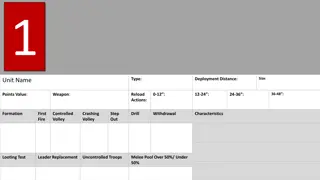
Sequential Switching Circuits and Flip-Flops
Explore the world of sequential circuits and flip-flops, covering topics such as shift registers, counters, and more. Learn about the differences between sequential and combinational circuits, along with the functionality of flip-flops and latches. Dive into the fundamentals of memory elements and the workings of S-R flip-flops in this detailed guide.
Download Presentation

Please find below an Image/Link to download the presentation.
The content on the website is provided AS IS for your information and personal use only. It may not be sold, licensed, or shared on other websites without obtaining consent from the author. If you encounter any issues during the download, it is possible that the publisher has removed the file from their server.
You are allowed to download the files provided on this website for personal or commercial use, subject to the condition that they are used lawfully. All files are the property of their respective owners.
The content on the website is provided AS IS for your information and personal use only. It may not be sold, licensed, or shared on other websites without obtaining consent from the author.
E N D
Presentation Transcript
Topics to be covered Flip-flops Applications of Flip-flops Shift registers Asynchronous counters Synchronous counters Sequential counters
Sequential Switching Circuits Sequential switching circuits are circuits whose output levels at any instant of time are dependent on the levels present at the inputs at that time and on the state of the circuit, i.e., on the prior input level conditions (i.e. on its past inputs) The past history is provided by feedback from the output back to the input. Made up of combinational circuits and memory elements. Eg. Counters, shift registers, serial adder, etc.
Sequential Switching Circuits Outputs Inputs Combinational Circuit Memory elements
Sequential Circuits v/s Combinational Circuits Sequential Circuits In sequential circuits, the output variables at any instant of time are dependent on the present input variables and on the present state, i.e., on the past history of the system. Memory unit is required to store the past history of the input variables in sequential circuits. Sequential circuits are slower than combinational circuits. Sequential circuits comparatively design. Combinational Circuits In combinational circuits, the output variables at any instant of time are dependent only on the present input variables. Memory unit is not required in combinational circuits. Combinational faster because between the input and the output is due to propagation delay of gates only. Combinational circuits are easy to design. circuits the are delay are to harder
Flip-flop A flip-flop, known formally as bistable multivibrator, has two stable states. It can remain in either of the states indefinitely. Its state can be changed by applying the proper triggering signal.
Latch Latch is used for certain flip-flop which are non-clocked. These flip-flops latchon to a 1 or a 0 immediately upon receiving the input pulse called SET or RESET.
S-R Flip-Flop (Latch) The simplest type of flip-flop is called an S-R latch. It has two outputs labelled Q and Q and two inputs labelled S and R. The state of the latch corresponds to the level of Q (HIGH or LOW, 1 or 0) and Q is the complement of that state. It can be constructed using either two cross-coupled NAND gates or two-cross coupled NOR gates. Using two NOR gates, an active-HIGH S-R latch can be constructed and using two NAND gates an active-LOW S- R latch can be constructed. The name of the latch, S-R or SET-RESET, is derived from the names of its inputs.
NOR Gate S-R latch (Active High) S Q Outputs Inputs R Q Logic Symbol S 0 0 0 0 1 1 1 1 R 0 0 1 1 0 0 1 1 Qn 0 1 0 1 0 1 0 1 Qn+1 0 1 0 0 1 1 x x State No Change R Q Reset Set Q Indeterminat e (invalid) S Logic diagram
NAND Gate S-R latch (Active Low) S 0 0 0 0 1 1 1 1 R 0 0 1 1 0 0 1 1 Qn 0 1 0 1 0 1 0 1 Qn+1 x x 1 1 0 0 0 1 State S Indeterminat e (invalid) Q Set Reset Q R Logic diagram No Change
Gated S-R Latch (S-R Flip flop) S EN Q R Q EN 1 1 1 1 1 1 1 1 0 0 S 0 0 0 0 1 1 1 1 x x R 0 0 1 1 0 0 1 1 x x Qn 0 1 0 1 0 1 0 1 0 1 Qn+1 0 1 0 0 1 1 x x 0 1 State Logic Symbol No Change S Reset Q Set EN Indetermina te (invalid) Q R No Change Logic diagram
Gated D-Latch What if shot both input of SR and put NOT gate at one input New flip flop is generated D- flip flop. Input will be given as output. D Mean Data. Also called Buffer flip flop. D EN Q Q Logic Symbol EN 1 1 1 1 0 0 D 0 0 1 1 x x Qn 0 1 0 1 0 1 Qn+1 0 0 1 1 0 1 State D Q Reset EN Set Q No Change Logic diagram
J-K Flip-Flop Invalid state of SR flip flop is corrected. New flip flop is JK flip flop. All other functionalities are same. J EN Q K Q EN 1 1 1 1 1 1 1 1 0 0 J 0 0 0 0 1 1 1 1 x x K 0 0 1 1 0 0 1 1 x x Qn 0 1 0 1 0 1 0 1 0 1 Qn+1 0 1 0 0 1 1 1 0 0 1 State Logic Symbol No Change Reset J Q Set EN Toggle Q No Change K
T Flip-Flop What If we shot both input of JK flip flop. New flip flop is generated called Toggle flipflop. Toggle = T Here Output will toggle(from its previous) if input is given 1 T EN Q Q Logic Symbol EN 1 1 1 1 0 0 T 0 0 1 1 x x Qn 0 1 0 1 0 1 Qn+1 0 1 1 0 0 1 State T Q No change Toggle EN No Change Q
Application of Flip flops Parallel Data Storage 1 flip flop to store 1 bit => N flip flop to store N bits data Data available at input of D-FF, on clock pulse data will be transferred to output Q. FF are connected parallelly. Serial Data Storage FF are cascaded. Transfer of Data Serially or parallelly Serial to Parallel conversion Parallel to serial conversion
Application of Flip flops Counting FF are connected in particular fashion to count pulses electronically called counters 1 FF can count up to 2 pulses. 2 FF can count up to 22 pulses =>n FF count - 2? ??????. Frequency division FF are connected in particular fashion to divide input frequenct called ripple counter 1 FF can be used to divide input frequency by 2 2 FF can divide frequency by 22 =>n FF can divide fr. By 2?.
Registers (Group of FF) As a flip-flop (FF) can store only one bit of data, a 0 or a 1, it is referred to as a single-bit register. A register is a set of FFs used to store binary data. The storage capacity of a register is the number of bits (1s and 0s) of digital data it can retain.
Registers Loading a register means setting or resetting the individual FFs, i.e. inputting data into the register so that their states correspond to the bits of data to be stored. Loading may be serial or parallel. In serial loading, data is transferred into the register in serial form i.e. one bit at a time. In parallel loading, the data is transferred into the register in parallel form meaning that all the FFs are triggered into their new states at the same time.
Types of Registers 1. Buffer register 2. Shift register 3. Bidirectional shift register 4. Universal shift register
Buffer register x3 x4 x2 x1 Q1 Q2 Q3 Q4 D1 > D2 > D3 > D4 > FF1 FF2 FF3 FF4 CLK CLK When clock pulse applied stored word Q becomes X Q4Q3Q2Q1=X1X2X3X4 or Q=X
Shift Register A number of FFs connected together such that data may be shifted into and shifted out of them is called a shift register. Data may be shifted into or out of the register either in serial form or in parallel form. So, there are four basic types of shift registers: 1. serial-in, serial-out 2. serial-in, parallel out 3. parallel-in, serial-out 4. parallel-in, parallel-out Data may be rotated left or right. Data may be shifted from left to right or right to left at will, i.e. in a bidirectional way. Also, data may be shifted in serially (in either way) or in parallel and shifted out serially (in either way) or in parallel.
Data transmission in shift register Serial data output Seri al data input Serial-in, serial-out shift-right, shift register Seri al data input Serial data output Serial-in, serial-out shift-left, shift register
Data transmission in shift register Seri al data input Parallel data output Serial-in, parallel-out, shift register Parallel data input Parallel data output Parallel-in, parallel-out, shift register
Data transmission in shift register Parallel data input Serial data output Parallel-in, serial-out, shift register
Serial-in, Serial-out, Shift register Serial Input Serial outpu t Q1 Q2 Q3 Q4 D1 > D2 > D3 > D4 > FF1 FF2 FF3 FF4 CLK
Serial-in, Serial-out, Shift register Using J-K Flip Flop Seri al input Serial outpu t Q1 Q2 Q3 Q4 J1 > J2 > J3 > J4 > FF1 FF2 FF3 FF4 K1 Q1 K2 Q2 K3 Q3 K4 Q4 CLK
Serial-in, Serial-out, Shift-left, Shift register Serial Output Serial input D4 D3 D2 D1 Q4 Q3 Q2 Q1 FF4 FF3 FF2 FF1 < < < < CLK
Serial-in, Parallel-out, Shift register Serial Input QA QC QB QD QA QB QC QD D1 > D2 > D3 > D4 > FF1 FF2 FF3 FF4 CLK
Parallel-in, Serial-out, Shift register A B C D Shif t/ Load Q1 Q2 Q3 Q4 D1 > D2 > D3 > D4 > FF1 FF2 FF3 FF4 CLK
Parallel-in, Parallel-out, Shift register C A B D Q Q Q Q D D D D FF1 FF2 FF3 FF4 > > > > CLK QA QC QB QD
Counters Synchronous counters and asynchronous counters Asynchronous counter = ripple counters
Asynchronous Counters v/s Synchronous Counters Asynchronous Counters In this type of counters FFs are connected in such a way that the output of the first FF drives the clock for the second FF, the output of the second the clock of the third and so on. All the FFs are not clocked simultaneously. Design and implementation is very simple even for more number of states. Synchronous Counters In this type of counters there is no connection between the output of first FF and clock input of next FF and so on. All simultaneously. the FFs are clocked Design becomes tedious and complex as the number of states increases. Since clock is applied to all the FFs simultaneously propagation delay is equal to the propagation delay of only one FF. Hence they are faster. and implementation Main drawback of these counters is their low speed as the clock is propagated through a number of FFs before it reaches the last FF. the total
2-bit Ripple Up-Counter using Negative Edge- triggered Flip-Flop 1 1 Q1 Q2 Present State Q2 0 0 1 1 Next State Q1 Q2 J1 J2 CLK Q1 0 1 0 1 Q2 0 1 1 0 Q1 1 0 1 0 CLK FF1 FF2 > > K1 Q1 K2 Q2 CLK 0 0 1 1 0 Q1 0 1 0 Q2
2-bit Ripple Down-Counter using Negative Edge- triggered Flip-Flop 1 1 Q1 Q2 Present State Q2 0 1 1 0 Next State CLK Q1 Q2 J1 J2 Q1 0 1 0 1 Q2 1 1 0 0 Q1 1 0 1 0 CLK FF1 FF2 > > K1 Q1 K2 Q2 CLK 0 0 1 1 0 Q1 1 1 0 0 1 Q1 0 0 1 Q2
2-bit Ripple Up-Counter using Positive Edge- triggered Flip-Flop 1 1 Q1 Q2 Present State Q2 0 0 1 1 Next State CLK Q1 Q2 J1 J2 Q1 0 1 0 1 Q2 0 1 1 0 Q1 1 0 1 0 CLK FF1 FF2 > > K1 Q1 K2 Q2 CLK Q1 1 1 1 0 0 0 Q1 0 0 0 1 1 1 Q2 0 1 0
2-bit Ripple Down-Counter using Positive Edge- triggered Flip-Flop 1 1 Q1 Q2 Present State Q2 0 1 1 0 Next State Q1 Q2 J1 > J2 > CLK Q1 0 1 0 1 Q2 1 1 0 0 Q1 1 0 1 0 CLK FF1 FF2 K1 Q1 K2 Q2 CLK Q1 1 1 1 0 0 0 Q2 0 1 0
Ring Counter Q1 Q2 Q3 Q4 D1 > D2 > D3 > D4 > FF1 FF2 FF3 FF4 Q1 Q3 Q4 Q2 CLK Q1 Q2 Q3 Q4 J1 > J2 > J3 > J4 > FF1 FF2 FF3 FF4 K4 K3 Q1 Q3 Q4 K2 K1 Q2 CLK
Ring Counter State Q2 0 1 0 0 0 1 0 0 After pulses 0 1 2 3 4 5 6 7 Q1 1 0 0 0 1 0 0 0 Q3 0 0 1 0 0 0 1 0 Q4 0 0 0 1 0 0 0 1
Mod-6 Asynchronous Counter State Q2 0 0 1 1 0 0 1 After pulses 0 1 2 3 4 5 6 Reset( R) 0 0 0 0 0 0 1 R = 0 for 000 to 101 R = 1 for 110 R = x for 111 R = Q3Q2Q1 + Q3Q2Q R = Q3Q2 Q3 0 0 0 0 1 1 1 Q1 0 1 0 1 0 1 0 0 0 0 1 0 0 0 0
Mod-6 Asynchronous Counter 1 Q 1 1 Q 2 1 Q 3 R Q1 Q2 Q3 T1 > T2 > T3 > FF1 FF2 CLK FF3 Q1 Q2 Q3 CLR CLR CLR
Exercise Design Mod-10 ripple counter. Draw a frequency divider using JK FFs to divide input clock frequency by a factor of 8.
Design of Synchronous Counters Step 1. Number of flip-flops: Based on the description of the problem, determine the required number n of the FFs - the smallest value of n is such that the number of states N 2n and the desired counting sequence. Step 2. State diagram: Draw the state diagram showing all the possible states. Step 3. Choice of flip-flops and excitation table: Select the type of flip-flops to be used and write the excitation table. An excitation table is a table that lists the present state (PS), the next state (NS) and the required excitations.
Design of Synchronous Counters Step 4. Minimal expressions for excitations: Obtain the minimal expressions for the excitations of the FFs using K-maps for the excitations of the flip-flops in terms of the present states and inputs. Step 5. Logic Diagram: Draw the logic diagram based on the minimal expressions.
Excitation Tables Require d inputs S 0 1 0 x Require d inputs J 0 1 x x PS NS PS NS Qn 0 0 1 1 Qn+1 0 1 0 1 S-R FF R x 0 1 0 Qn 0 0 1 1 Qn+1 0 1 0 1 J-K FF K x x 1 0
Excitation Tables Require d inputs D 0 1 0 1 Require d inputs T 0 1 1 0 PS NS PS NS Qn 0 0 1 1 Qn+1 0 1 0 1 D FF Qn 0 0 1 1 Qn+1 0 1 0 1 T FF
Design of Synchronous 3-bit Up Counters Step 1. Number of flip-flops: A 3-bit up-counter requires 3 flip-flops. The counting sequence is 000, 001, 010, 011, 100, 101, 110, 111, 000 Step 2. Draw the state diagram: 000 111 001 110 010 101 011 100
Design of Synchronous 3-bit Up Counters Step 3. Select the type of flip-flops and draw the excitation table: JK flip-flops are selected and the excitation table of a 3-bit up-counter using J-K flip-flops is drawn as shown below. PS NS Q3 0 0 0 0 0 1 0 0 1 0 1 0 0 1 0 0 1 1 0 1 1 1 0 0 1 0 0 1 0 1 1 0 1 1 1 0 1 1 0 1 1 1 1 1 1 0 0 0 Required excitations K3 x 0 x 1 x x x x 0 0 0 1 0 x 1 x Q2 Q1 Q3 Q2 Q1 J3 0 0 0 1 x x x x J2 K2 x x 0 1 x x 0 1 J1 1 x 1 x 1 x 1 x K1 x 1 x 1 x 1 x 1
Design of Synchronous 3-bit Up Counters Step 4. Obtain the minimal expressions From excitation table, J1 = K1 = 1. K Maps for excitations J3, K3, J2 and K2 and their minimized form are as follows: Q3Q2 Q1 0 Q3Q2 Q1 0 00 11 00 11 01 10 x 01 x 10 x x x x x 1 x 1 1 1 J3 = Q2Q1 K3 = Q2Q1
Design of Synchronous 3-bit Up Counters Q3Q2 Q1 0 Q3Q2 Q1 0 00 11 x 00 11 01 x 10 01 10 x x x x 1 1 1 1 x x 1 1 J2 = Q1 K2 = Q1
Design of Synchronous 3-bit Up Counters Step 5. Draw the logic diagram 1 Q1 Q2 Q3 J1 > J2 > J3 > FF1 FF2 FF3 K1 Q1 K2 Q2 K3 Q3 CLK










